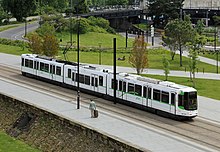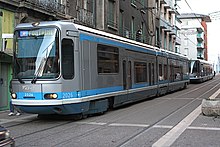Tramway français standard

The Tramway français standard (abbreviation TFS) is a tram series that was developed and built by the French company GEC Alsthom in connection with the renaissance of trams in France that began around 1980 . More than 150 sets were delivered between 1987 and 1997.
prehistory
In the mid-1970s it became apparent in France that the previous transport policy, which also favored car traffic in cities, was failing and that there was an urgent need to further develop local public transport . It was recognized that for medium-sized cities a tram with its own route can transport more people and is also faster than buses and, on the other hand, is considerably cheaper to build and operate than an underground train .
Starting in 1975, the French government called on eight French cities with the so-called Concours Cavaillé to work out proposals for the use of trams.
1st generation: high-floor TFS (Nantes type)
Initially, none of the cities addressed in the Concours Cavaillé reacted. But when, in 1978, Nantes decided to build a tram network, tram trains were developed that were to become the standard in France.
On November 6, 1981, the then Minister of Transport, Charles Fiterman, signed an agreement to help the state invest in the construction of the first “Tramway français standard”, from which the Nantes transport company ordered 20 vehicles. This tram car was designed between 1979 and 1980 by a consortium led by the GEC Alsthom company. The companies MTE -Francorail and TCO-Oerlikon were involved in the construction .
It was a high-floor two-way articulated wagon with two motor bogies and a Jakobs bogie as a running bogie under the joint. It was 28.3 m long, 2.3 m wide and had 60 seats and 178 standing places. The drive was carried out by a longitudinally installed DC drive motor with cardan shaft transmission to both wheelsets.
As the number of passengers increased, it became necessary to use two coupled units , which required the installation of suitable coupling elements and multiple controls. An automatic clutch was chosen . On the occasion of the commissioning of line 2 of the Nantes tram and given the success of the Grenoble tram , a third low-floor box was inserted between the two car bodies .
The Nantes tram has 46 vehicles of this type.
2nd generation: partially low-floor (Grenoble type)
The desired low-floor section required a fundamental design change. The wagons were made up of three parts ; instead of the joint above the Jakobs bogie , an additional middle wagon body with a two-axle bogie and loose wheel sets was added. The four entry doors on each side are in the low-floor area of the two end car bodies.
The 29.4 m long vehicles built by GEC Alsthom are low-floor with a floor height in the middle of 35 cm and a length of 19.3 m. To get to the seats above the drive bogies at the ends of the vehicle, three steps have to be overcome, where the floor height is 86 cm.
Grenoble
A total of four variants of the TFS are in use in Grenoble - the last series with IGBT control of the power supply.
Greater Paris and Rouen
At the time of ordering the vehicles for line 1 of the Paris tram (Saint-Denis – Bobigny) and for the Rouen tram , the TFS was the only tram offered by French manufacturers. Line 2 in Paris (Issy-Val de Seine-La Défense), which opened in 1997 , also initially received TFS, which were soon transferred to Line 1 due to their insufficient capacity.
Special case of Saint-Etienne
In the 1980s, the Saint-Étienne tram was faced with the need to replace the outdated PCC vehicles . Since the meter gauge was to be kept in Saint-Étienne , GEC Alsthom developed a meter-gauge variant of the TFS in cooperation with the companies Vevey (car body), Duewag (articulation, bogies) and Faiveley (folding doors). Like the standard gauge wagons of the series design, it is low-floor between the motor bogies, but in contrast to the standard-gauge TFS wagons, it is only made up of two parts. In addition, there are one-way vehicles in Saint-Étienne. The width of the car body, with a length of 23.24 meters, is only 2100 millimeters. The running bogie is a small wheel bogie that has been moved forward. The rear car body rests on the end of the front one.
A first partial delivery took place in 1991, the first vehicle arrived on July 30, 1991. The TFS initially operated in mixed operation with a few PCCs. After the second partial delivery (1998) the remaining PCCs were parked.
statistics
| place | Installation | Number of sets | comment |
|---|---|---|---|
| Nantes | 1984-1985 + 1988-1994 | 46 | 2 deliveries |
| Grenoble | 1987-1997 | 53 | 4 deliveries |
| Saint-Etienne | 1991 + 1998 | 35 | 2 deliveries |
| Paris line T1 | 1992 + 1996/1997 | 17 + 2 | 1. Delivery of direct current motors 2. Delivery of three-phase asynchronous motors |
| Paris line T2 | 1996/1997 | 16 | Three-phase asynchronous motors; 2003/2004 for T1 |
| Rouen | 1994 | 28 | Sold to Gaziantep in 2013 |
Technical specifications
| Nantes design | Construction type Nantes (conversion) | Grenoble type | Saint-Étienne type | |
|---|---|---|---|---|
| length | 28.30 m | 39.15 m | 29.40 m | 23.24 m |
| width | 2.30 m | 2.30 m | 2.30 m | 2.10 m |
| height | 3.25 m | 3.25 m | 3.36 m | |
| Gauge | 1435 mm | 1435 mm | 1435 mm | 1000 mm |
| Empty weight | 51.96 t | 44.6 t | 27.4 t | |
| power | 550 kW | |||
| Top speed | 70 km / h | 70 km / h | ||
| Seats | 60 | 68 | 52 | 39 |
| Standing room | 178 | 285 | 126 | 163 |
Location of the vehicles
The disadvantage of the TFS sets of the Nantes design was that initially there was no low-floor area, which made it difficult to get on and off quickly.
Since in the meantime foreign designers offered tram cars with a large proportion of low-floor vehicles. B. Siemens from 1996 the Combino , Alstom developed the Citadis , which was a great success especially in France. The last orders for the TFS came from Grenoble or were intended for line 2 of the Paris tram .
Although the TFS wagons are still in service, they have found support from other series:
- in Nantes they are supplemented by the Incentro type cars from the German manufacturer Adtranz (now part of the Canadian group Bombardier ),
- Alstom Citadis are also used in Grenoble ,
- in Paris they were replaced by Citadis on the RATP line T2 , and the cars have been in use on the T1 line since then .
In Rouen, Citadis 402s replaced the TFS trains between late 2011 and early 2013, which were then sold to the Turkish city of Gaziantep .





